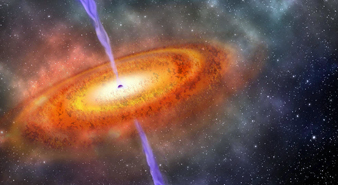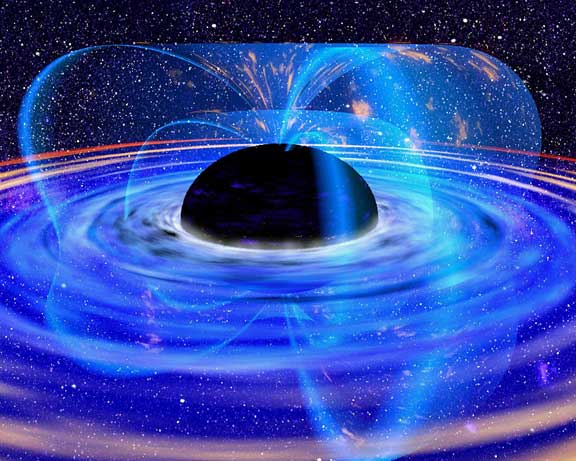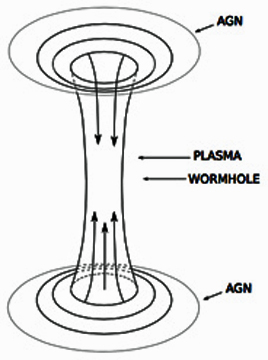|
While merging black holes and supernovae release enormous amounts of energy, they are transient — the former lasts less than a second, and the latter a few months.
Conversely, active galactic nuclei (AGN) are persistent sources of immense energy, lasting perhaps billions of years. The most powerful AGN seem to come from compact sources; these are called quasars, as shown in this sketch by Robin Dienel. Those producing jets aimed right at us are called blazars.

The conventional wisdom is that the sources of AGN, quasars, and blazars are supermassive black holes. These monsters can contain the mass of more than 60 billion Suns. As gas, stars, and the odd planet fall toward them into eternal oblivion, some portion of their energy radiates outward, often in narrow jets of enormous power. This artist’s conception is provided by NASA.

A key problem with the conventional wisdom is understanding how supermassive black holes could become so massive so quickly. We understand how black holes of about 10 solar masses form from the catastrophic collapse of large dying stars, and we know black holes can grow by accreting surrounding matter. But, growing from 10 to 10 billion solar masses in only a few 100 million years is a huge leap beyond existing theories.
Now, Piotrovich, Kasnikov, and Natsvlishvili of the Astronomical Observatory of St. Petersburg, Russia, propose a remarkable alternative — they say AGNs are produced, not by supermassive black holes, but by wormholes.
PKN imagine a wormhole connecting two regions of space, as shown here, with immense energy spewing out each wormhole mouth, creating the effects we have called AGN, quasars, and blazars.

In the PKN scheme, the cylindrical surface shown here contains some exotic matter of negative energy density — not specified therein; they say “its nature is irrelevant".
Normal matter (all known matter has positive energy) falling into one mouth of the wormhole will collide with normal matter falling into the other mouth. As a result, a high-energy plasma forms in the wormhole’s neck.
The negative energy density of the wormhole’s cylindrical surface must substantially exceed the positive energy density of the plasma inside to prevent the wormhole from collapsing. Let me emphasize that negative energy has never been observed, and no serious physical theory proposes its existence.
PKN consider one imagined example in their paper: a wormhole joining two AGNs each with energy equivalent to the mass of 500 million Suns, and with 1 solar mass of normal matter falling in per year for 100 million years. They calculate a plasma density of 3 trillionths the density of water, with a temperature of 100 trillion Kelvin. At that high temperature, collisions within the plasma would produce π0 mesons that decay to pairs of 68 MeV gamma rays, thus providing a distinctive signature.
If anyone detects 68 MeV gamma rays from an AGN, we’ll all have to learn to pronounce Piotrovich, Kasnikov, and Natsvlishvili.

Best Regards,
Robert
January 2021
Note: Previous newsletters can be found on my website.
|